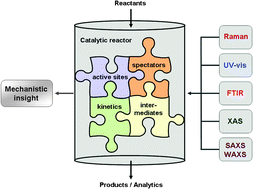Several in situ techniques are known which allow investigations of catalysts and catalytic reactions under real reaction conditions using different spectroscopic and X-ray methods. In recent years, specific set-ups have been established which combine two or more in situ methods in order to get a more detailed understanding of catalytic systems. This tutorial review will give a summary of currently available set-ups equipped with multiple techniques for in situ catalyst characterization, catalyst preparation, and reaction monitoring. Besides experimental and technical aspects of method coupling including X-ray techniques, spectroscopic methods (Raman, UV-vis, FTIR), and magnetic resonance spectroscopies (NMR, EPR), essential results will be presented to demonstrate the added value of multitechnique in situ approaches. A special section is focussed on selected examples of use which show new developments and application fields.
You have access to this article
 Please wait while we load your content...
Something went wrong. Try again?
Please wait while we load your content...
Something went wrong. Try again?


 Please wait while we load your content...
Please wait while we load your content...